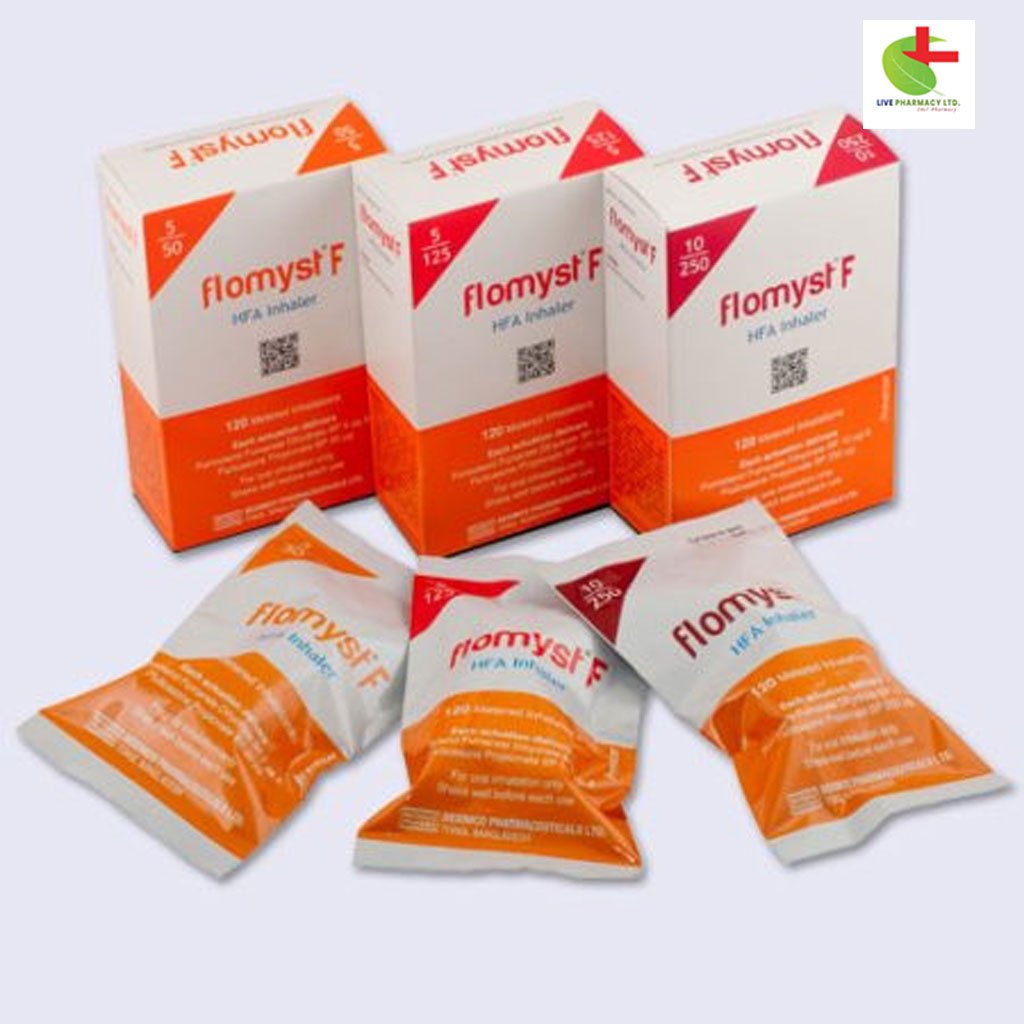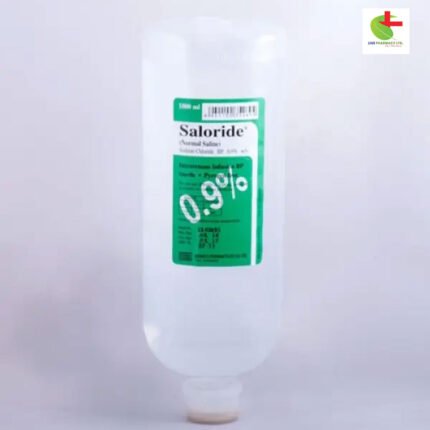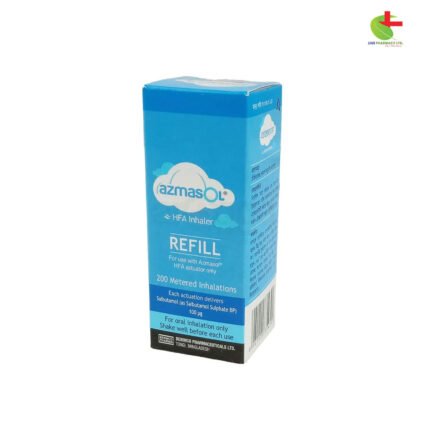Flomyst-F 5/125 HFA
625.00৳ Pcs
- Flomyst F is a combination inhaler containing Fluticasone Propionate and Formoterol Fumarate, designed for managing asthma and COPD.
- It reduces lung inflammation and keeps airways open, improving breathing in patients.
- Suitable for adults and adolescents (12+ years) with asthma, and for adults with COPD.
- Regular use helps prevent symptoms, but it is not intended for immediate relief during asthma attacks.
 Brand
Brand
|
Beximco Pharmaceuticals Ltd |
|---|---|
 Generics
Generics
|
Fluticasone Propionate + Formoterol Fumarate |
 Type
Type
|
Inhaler |
Indications
Asthma: Flomyst F, a combination of Fluticasone Propionate and Formoterol Fumarate, is designed for the routine management of asthma where a combination therapy (inhaled corticosteroid and long-acting ß2 agonist) is needed:
- For patients who are inadequately controlled with inhaled corticosteroids and require a short-acting ß2 agonist.
- For those already stabilized on both an inhaled corticosteroid and a long-acting ß2 agonist.
Flomyst F (Fluticasone Propionate 125 mcg and Formoterol Fumarate 5 mcg) is intended for adults and adolescents aged 12 years and older.
COPD: Flomyst F is recommended for patients requiring long-acting ß2 agonist/inhaled corticosteroid therapy and who are unable to use alternative inhalers.
This inhaler formulation (125 mcg Fluticasone Propionate and 5 mcg Formoterol Fumarate) is approved for adult use only.
Pharmacology
Flomyst F is a pressurized inhalation suspension that contains:
- Fluticasone Propionate: A steroid that reduces lung inflammation and swelling.
- Formoterol Fumarate Dihydrate: A long-acting ß2 agonist that keeps airways open, improving breathing.
These ingredients work synergistically to enhance respiratory function. Daily use, as prescribed, is recommended to prevent conditions like asthma, though it will not act as a quick-relief treatment for asthma attacks. For immediate relief, a fast-acting bronchodilator (e.g., salbutamol) should be used.
Dosage
Training: Patients must be trained on the proper use of the inhaler. Regular checkups with a healthcare provider will ensure that the dose remains optimal.
For asthma:
- Adults and adolescents (12+ years): Two inhalations (puffs) twice daily, typically in the morning and evening.
- Adults with severe asthma: The dose may be increased to the highest available strength (Fluticasone Propionate 250 mcg & Formoterol Fumarate 10 mcg) with two puffs twice daily.
- Children under 12: This inhaler is not recommended due to a lack of available data.
For COPD:
- Adults only: Two puffs of the 250 mcg Fluticasone Propionate & 10 mcg Formoterol Fumarate inhaler, twice daily.
Administration
Using an inhaler correctly is critical to ensure proper delivery of medication to the lungs. Incorrect use may reduce the effectiveness of the treatment. Here’s how to use Flomyst F effectively, according to the National Asthma Guidelines:
- Remove the cap.
- Shake the inhaler vigorously.
- Test the inhaler by releasing a puff into the air if it’s new or hasn’t been used in a week.
- Exhale fully, place the mouthpiece in your mouth, and close your lips around it.
- As you breathe in deeply, press down on the canister to release the medication.
- Hold your breath for at least 10 seconds, then remove the inhaler.
- If you need another puff, wait 1 minute and repeat.
- After use, rinse your mouth with water.
Regular cleaning of the inhaler is necessary. Detach the canister, rinse the actuator and cap with warm water, and allow them to dry before reassembling.
Interaction
No formal drug interaction studies have been conducted with Flomyst F. Fluticasone Propionate, a key component, is metabolized by CYP 3A4, meaning interactions with CYP 3A4 inhibitors (e.g., Ritonavir, Clarithromycin, Ketoconazole) could occur. Co-administration should be cautious and ideally avoided for long-term treatments.
Contraindications
Flomyst F should not be used to manage acute asthma attacks. Patients should always carry a fast-acting bronchodilator for immediate relief during exacerbations. This inhaler should not be initiated during severe asthma flare-ups and should be used with caution in patients with conditions such as pulmonary infections, diabetes, and severe cardiovascular disorders.
Systemic effects from corticosteroid use, like Cushing’s syndrome or adrenal suppression, are possible, but these risks are lower with inhaled corticosteroids compared to oral formulations.
Side Effects
The use of Flomyst F may lead to paradoxical bronchospasm, presenting as wheezing and shortness of breath. If hypersensitivity reactions occur, alternative asthma treatment should be considered. Common side effects include dysphonia and oral candidiasis, which can be mitigated by gargling or rinsing the mouth after each use.
Pregnancy & Lactation
There is limited data on the use of Flomyst F during pregnancy. It should only be prescribed if the benefits to the mother outweigh potential risks to the fetus. Similarly, there is no conclusive evidence regarding the excretion of Fluticasone Propionate or Formoterol Fumarate into breast milk.
Use in Special Populations
- Elderly patients: No dosage adjustment is necessary.
- Pediatric patients: The use of Flomyst F in children under 12 is not recommended.
- Hepatic or renal impairment: There is no data on Flomyst F usage in these conditions.
Overdose
Overdose symptoms from Formoterol could include palpitations, muscle cramps, or hyperglycemia. Overdose of Fluticasone Propionate is less concerning but may result in temporary suppression of adrenal function.
Storage
Store in a cool, dry place, away from direct sunlight.













Reviews
There are no reviews yet.